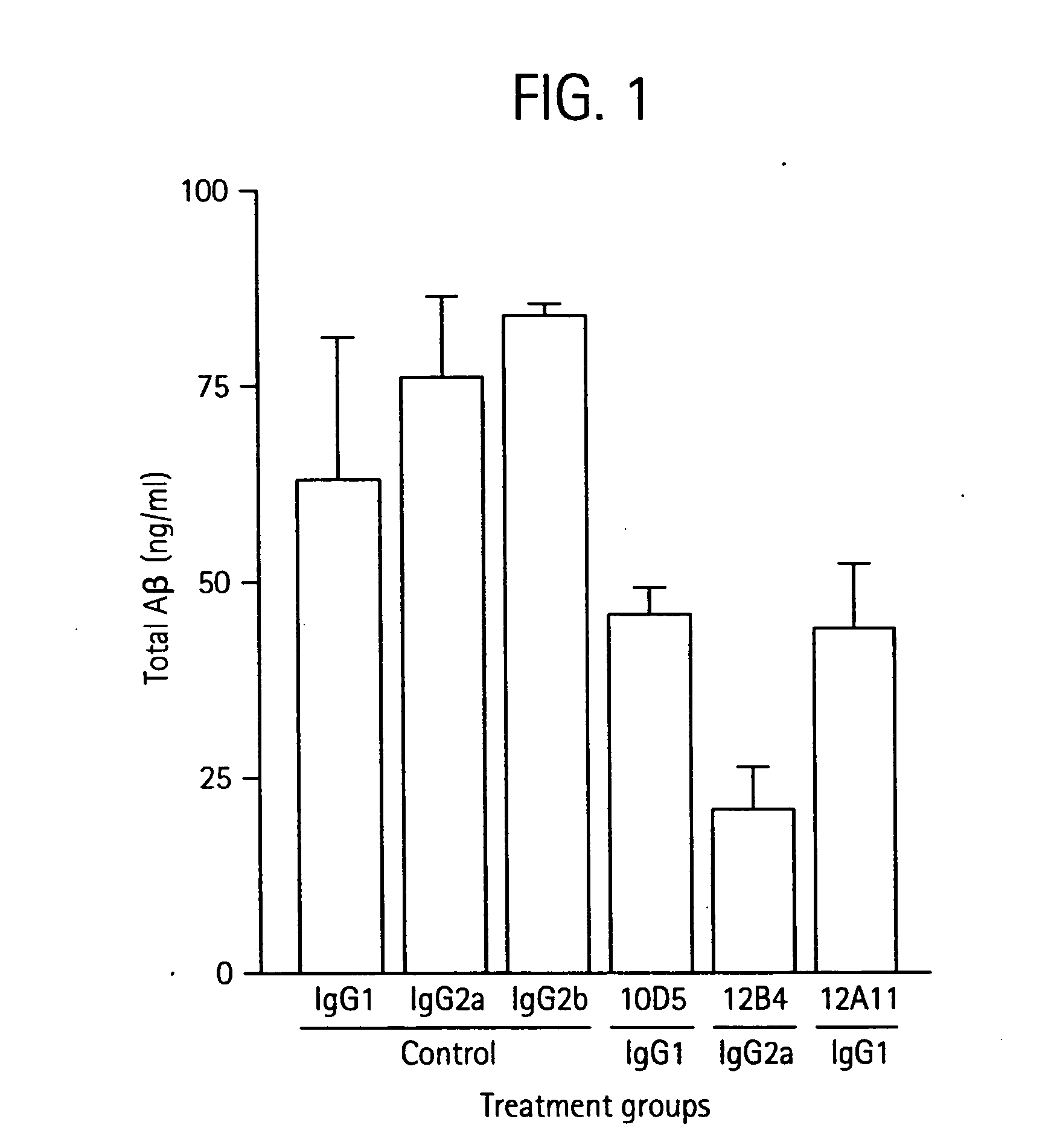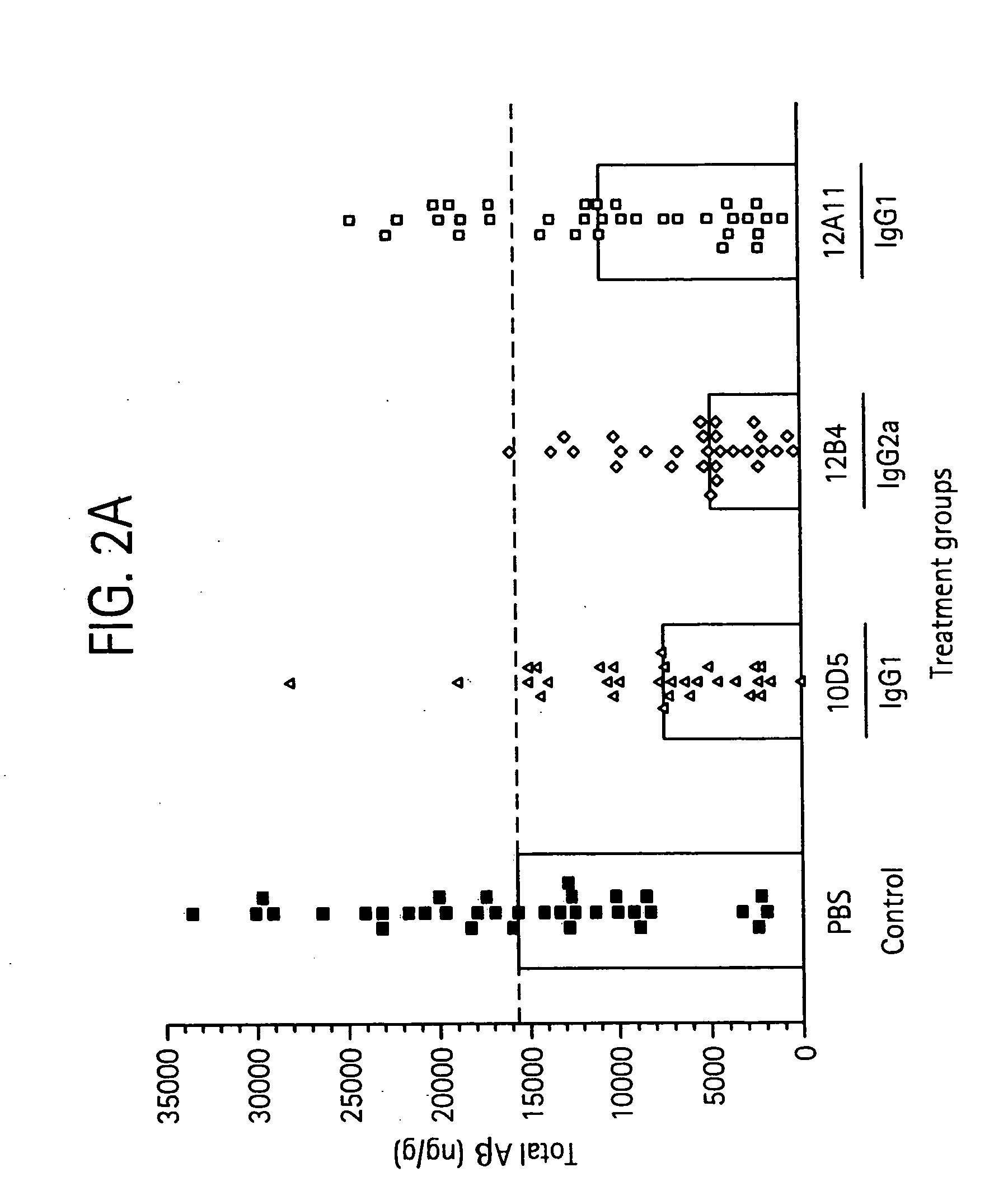Humanized Abeta antibodies for use in improving cognition
a technology of human abeta and cognition, which is applied in the field of humanized abeta antibodies for use in improving cognition, can solve the problems of inability to learn or effectively form new memories or old ones, patients with dementia require increasingly costly and intensive caregiving, and the cognition pathway is impaired. , to achieve the effect of reducing plaque burden and improving cognition
- Summary
- Abstract
- Description
- Claims
- Application Information
AI Technical Summary
Benefits of technology
Problems solved by technology
Method used
Image
Examples
examples
[0370] The following Sequence identifiers are used throughout the Examples section to refer to immunoglobulin chain variable region nucleotide and amino acid sequences.
VL nucleotideVL amino acidVH nucleotideVH amino acidAntibodysequencesequencesequencesequence12A11SEQ ID NO: 1SEQ ID NO: 2SEQ ID NO: 3SEQ ID NO: 4(coding)(coding)12A11v1SEQ ID NO: 34SEQ ID NO: 7SEQ ID NO: 35SEQ ID NO: 1012A11v2SEQ ID NO: 34SEQ ID NO: 7SEQ ID NO: 1312A11v2.1SEQ ID NO: 34SEQ ID NO: 7SEQ ID NO: 1412A11v3SEQ ID NO: 34SEQ ID NO: 7SEQ ID NO: 1512A11v3.1SEQ ID NO: 34SEQ ID NO: 7SEQ ID NO: 37SEQ ID NO: 3612A11v4.1-8SEQ ID NO: 34SEQ ID NO: 7SEQ ID NOs: 16-31
[0371] As used herein, an antibody or immunoglobulin sequence comprising a VL and / or VH sequence as set forth in any one of SEQ ID NOs:1-4, 7, 10, 13-31, and 34-37 can comprise either the full sequence or can comprise (or encode) the mature sequence (i.e., mature peptide without the signal or leader peptide).
example i
Ex vivo Efficacy of Mouse 12A11 Antibody
[0372] Previous studies have shown that it is possible to predict in vivo efficacy of various Aβ antibodies in reducing AD-associated neuropathology (e.g., plaque burden) by the ability of antibodies to bind plaques ex vivo (e.g., in PDAPP or AD brain sections) and / or trigger plaque clearance in an ex vivo phagocytosis assay (Bard et al. (2000) Nat. Med. 6:916-919). The correlation supports the notion that Fc-dependent phagocytosis by microglial cells and / or macrophages is important to the process of plaque clearance in vivo. However, it has also been reported that antibody efficacy can also be obtained in vivo by mechanisms that are independent of Fc interactions (Bacskai et al. (2002) J. Neurosci. 22:7873-7878). Studies have indicated that an antibody directed against the midportion of Aβ, which cannot recognize amyloid plaques, appears to bind to soluble Aβ and reduce plaque deposition (DeMattos et al. (2001) Proc. Natl. Acad. Sci. USA 98:...
example ii
In vivo Efficacy of Mouse 12A11 Antibody: Reduction of AD Neuropathology
[0379] Mouse Antibody 12A11 Reduces Alzheimer's-Like Neuropathology In Vivo To determine the in vivo efficacy of 12A11, antibodies (including 12A11, 12B4, or 10D5) were administered to mice at 10 mg / kg by weekly intraperitoneal injection for 6 months as described in Bard et al. (2000) Nat. Med. 6:916. At the end of the study, total levels of cortical Aβ were determined by ELISA. As shown in FIG. 2A, each of the antibodies significantly reduced total Aβ levels compared with the PBS control (P<0.001), i.e. 12B4 showed a 69% reduction, 10D5 showed a 52% reduction, and 12A11 showed a 31% reduction.
[0380] The level of neuritic dystrophy was then examined in sections of brain tissue from the above-mentioned mice to determine the association between plaque clearance and neuronal protection. Data from brain image analyses examining the percentage of frontal cortex occupied by neurotic dystrophy is shown in FIG. 2B. Th...
PUM
| Property | Measurement | Unit |
|---|---|---|
| time | aaaaa | aaaaa |
| time | aaaaa | aaaaa |
| time | aaaaa | aaaaa |
Abstract
Description
Claims
Application Information
 Login to View More
Login to View More - R&D
- Intellectual Property
- Life Sciences
- Materials
- Tech Scout
- Unparalleled Data Quality
- Higher Quality Content
- 60% Fewer Hallucinations
Browse by: Latest US Patents, China's latest patents, Technical Efficacy Thesaurus, Application Domain, Technology Topic, Popular Technical Reports.
© 2025 PatSnap. All rights reserved.Legal|Privacy policy|Modern Slavery Act Transparency Statement|Sitemap|About US| Contact US: help@patsnap.com



